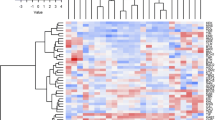Abstract
Maize (Zea mays L.) landraces are an important source for the genetic improvement of the crop. Classification of genetic resources requires both appropriate descriptors as well as sound numerical and statistical methods. This research was undertaken to assess the use of six internal ear traits for classifying a set of four related Peruvian highland maize races comprising a total of 24 accessions. Several accessions of the four races were included in field trials planted in Peru’s inter-Andean valley. The trials were sown on two planting dates (normal and late) in two consecutive years. Variance components among races and among accessions with races were used to estimate broad-sense heritability and repeatability for each internal ear trait. The Ward-Modified Location model (MLM) and canonical analysis were undertaken for clustering the 24 accessions. For most traits, the variance components among races were more important than the accession within races, and the variance components for race × environment or accession within race × environment were, for the most part, negligible. Results suggest that internal ear traits such as cob and pith diameter, as well as cupule sizes and glume texture, are among the most appropriate for clustering these materials in their respective races. The numerical classification maintained the structure of the more differentiated races but identified two distinct accessions in one race and separated them into a homogeneous group. The Ward-MLM numerical method produced groups with distinct characteristics in terms of internal ear variables.



Similar content being viewed by others
References
Abu-Alrub I, Christiansen JL, Madsen S, Sevilla R, Ortiz R (2004) Assessing tassel, kernel and ear variation in Peruvian highland maize. Plant Genet Resour Newsletter 137:34–41
Anderson E, Cutler HC (1942) Races of Zea mays. I. Their recognition and classification. Ann Mo Bot Gard 29:69–88
Binder DA (1978) Bayesian cluster analysis. Biometrika 65:31–38
Brieger FG, Gurgel JTA, Paterniani E, Blumenschein A, Alleoni MR (1958) Races of maize in Brazil and other eastern South American countries. Natl Acad Sci Natl Res Council Pub 593, Washington, DC
Crossa J, Franco J (2004) Statistical methods for classifying genotypes. Euphytica 137:19–37
Cutler HC (1946) Races of maize in South America. Bot Mus Leafl Harvard Univ 12:257–291
Everitt BS (1981) A Monte Carlo investigation of the likelihood ratio test for the number of components in a mixture of normal distributions. Multivar Behav Res 16:171–180
Franco J, Crossa J, Villaseñor J, Castillo A, Taba S, Eberhart SA (1998) Classifying genetic resources by categorical and continuous variables. Crop Sci 38:1688–1696
Franco J, Crossa J, Villaseñor J, Castillo A, Taba S, Eberhart SA (1999) A two-stage, three-way method for classifying genetic resources in multiple environments. Crop Sci 39:259–267
Goodman MM, Paterniani E (1969) The races of maize. III: Choices of appropriate characters for racial classification. Econ Bot 23:265–273
Grobman A, Salhuana W, Sevilla R, Mangelsdorf PC (1961) Races of maize in Peru: their origins, evolution and classification. Natl Acad Sci Natl Res Council Pub 915, Washington, DC
Gutierrez L, Franco J, Crossa J, Abadie T (2003) Comparing preliminary racial classification with a numerical classification of the maize landraces of Uruguay. Crop Sci 43:718–727
Hatheway WH (1957) Races of maize in Cuba. Natl Acad Sci Natl Res Council Pub 453, Washington, DC
Lawrence CJ, Krzanowski WJ (1996) Mixture separation for mixed-mode data. Stat Comput 6:85–92
Mardia KV, Kent JT, Bibby JM (1979) Multivariate analysis. Academic Press, London
Milligan GW, Cooper M (1985) An examination of procedures for determining the number of clusters in a data set. Psychometrika 50–2:159–179
Nickerson NH (1953) Variation in cob morphology among certain archaeological and ethnological races of maize. Ann Missouri Bot Gard 40:79–111
Ortiz R, Crossa J, Franco J, Sevilla R, Burgueño J (2007) Classification of Peruvian highland maize races using plant traits. Genet Resour Crop Evol. doi:10.1007/s10722-007-9224-7
Ortiz R, Sevilla R (1997) Quantitative descriptors for classification and characterization of highland Peruvian maize. Plant Genet Resour Newsl 110:49–52
Ramírez RE, Timothy DH, Díaz E, Grant UJ, Nicholson GE, Anderson E, Brown WL (1960) Races of maize in Bolivia. Natl Acad Sci Natl Res Council Pub 747, Washington, DC
Roberts LM, Grant UJ, Ramírez RE, Hatheway WH, Smith DL, Mangelsdorf PC (1957) Races of maize in Colombia. Natl Acad Sci Natl Res Council Pub 510, Washington, DC
Sanchez JJ, Goodman MM, Rawlings JO (1993) Appropriate characters for racial classification in maize. Econ Bot 47:44–59
SAS Institute Inc. (1999) SAS OnlineDoc®, Version 8. SAS Institute Inc., Cary, North Carolina
Taba S, Díaz J, Franco J, Crossa J (1998) Evaluation of Caribbean maize accessions to develop a core subset. Crop Sci 38:1378–1386
Taba S, Díaz J, Franco J, Crossa J, Eberhart SA (1999) A core subset of LAMP from the Latin American Maize Project. CD-Rom. CIMMYT, Mexico DF
Ward J (1963) Hierarchical grouping to optimize an objective function. J Am Stat Assoc 58:236–244
Wellhausen EJ, Fuentes A, Hernández Corzo A, Mangelsdorsf PC (1957) Races of maize in Central America. Natl Acad Sci Natl Res Council Pub 511, Washington, DC
Wellhausen EJ, Roberts LM, Hernández XE, Mangelsdorf PC (1952) Races of maize in Mexico. Bussey Inst, Harvard University, Cambridge
Wolfe JH (1970) Pattern clustering by multivariate mixture analysis. Multivar Behav Res 5:329–350
Author information
Authors and Affiliations
Corresponding author
Rights and permissions
About this article
Cite this article
Ortiz, R., Sevilla, R., Alvarado, G. et al. Numerical classification of related Peruvian highland maize races using internal ear traits. Genet Resour Crop Evol 55, 1055–1064 (2008). https://doi.org/10.1007/s10722-008-9312-3
Received:
Accepted:
Published:
Issue Date:
DOI: https://doi.org/10.1007/s10722-008-9312-3




